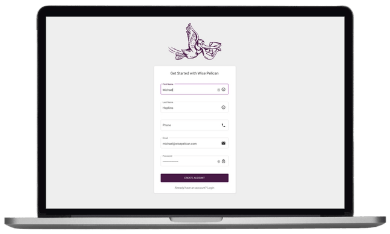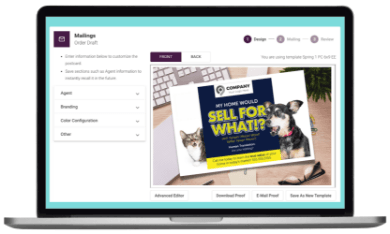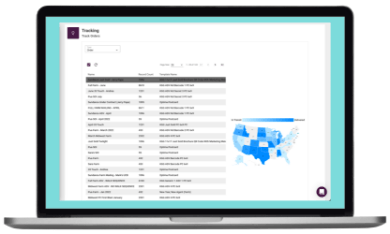If you would prefer to watch a video on real estate letters to potential sellers, we have included our YouTube video.
Effective communication is the cornerstone of success in real estate. While numerous methods exist to reach potential buyers, the classic real estate letter is one of the most influential and versatile tools.
This comprehensive guide will tackle the art of mailing letters to home sellers, exploring various tactics, letter types, and strategies to help you secure listings and grow your real estate business.
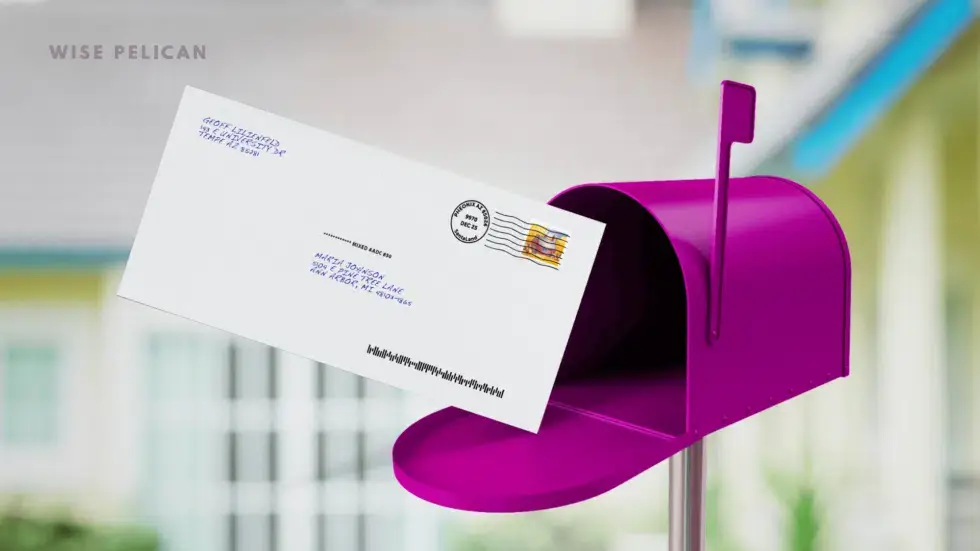
Why Focus on Mailing Letters to Potential Sellers?
While you should certainly use real estate letters to attract buyers, in this article the focus is how to connect with homeowners considering selling their properties. Let’s explore the reasons behind this approach and how it can benefit your real estate business.
Brand Awareness
Building brand awareness through mailing real estate letters to potential sellers is a strategic marketing approach that can yield long-term benefits for real estate professionals and agencies.
This method sends personalized, informative, and visually appealing letters to potential home sellers in a targeted area. The following is an explanation of how this strategy can help establish and strengthen your brand:
- Personalized Communication: Mailing letters allows you to establish a personal connection with potential home sellers. Personalization is key, showing that you’ve taken the time to understand their needs and preferences. Mentioning specific details about their neighborhood or property can create a sense of trust and rapport.
- Visual Identity: Your mailed letters should incorporate your agency’s logo, colors, and other branding elements. Consistency in visual identity helps reinforce your brand’s image and makes it more recognizable over time. When people repeatedly encounter your brand, it becomes more ingrained in their memory.
- Educational Content: Beyond promoting your brand, your letters should offer valuable and relevant information. Consider including tips on preparing a home for sale, market trends, or recent successful sales in the area. You position yourself as a knowledgeable and trustworthy resource by providing helpful content.
- Consistency is Key: Consistency in your mailing strategy is vital for brand awareness. Regularly sending letters to home sellers keeps your brand in their minds. This consistency can be achieved through a well-planned mailing schedule, such as monthly or quarterly mailings.
- Subtle Reminder: Mailing letters are a subtle but effective reminder that you can assist with their real estate needs when the time comes. Even if they aren’t immediately ready to sell, your brand will be associated with real estate expertise and reliability.
- Multi-Channel Approach: Combining mailed letters with other marketing channels can amplify your brand awareness efforts. Consider integrating your direct mail campaign with online marketing, social media, and email marketing to create a comprehensive approach that reaches potential sellers through various points of contact.
- Tracking and Analytics: Utilize tracking and analytics tools to measure the impact of your direct mail campaign. Monitor response rates, website visits, and lead generation originating from your mailed letters. This data can help refine your strategy over time.
- Test and Adapt: Feel free to experiment with different messaging, designs, or target demographics to see what works best for your audience. Continuously refine your approach based on the feedback and results you receive.
- Long-Term Brand Building: Building brand awareness through mailed letters is a long-term strategy. It may take time for recipients to become actual clients, but the consistent presence of your brand will make a lasting impression.
Mailing letters to home sellers is a valuable brand awareness strategy that combines personalization, visual identity, informative content, and consistency to create a lasting impression.

Proof of Production Letters
Proof of production letters are a powerful marketing tool in the real estate industry to engage potential home sellers and establish credibility as a real estate professional.
These letters come in various forms, such as “just listed,” “just sold,” and market update letters. Their effectiveness depends on the specific action you’re taking in the neighborhood.
Let’s look at how proof of production letters can be a valuable component of your real estate marketing strategy:
- Just Listed Letters:
- Purpose: These letters are typically sent when you have recently listed a property in the recipient’s neighborhood. They inform residents about the new listing and generate interest among potential sellers.
- Content: Just listed letters should highlight the key features of the property, its selling points, and why it’s a great time to sell in the current market conditions. Include high-quality images to showcase the property’s appeal.
- Just Sold Letters:
- Purpose: Sending just sold letters demonstrates your ability to close deals in the area successfully. These letters can reassure potential sellers that you have a track record of selling homes in their neighborhood.
- Content: Share the details of the recently sold property, including the sale price, days on the market, and any particular strategies or marketing techniques you used to achieve a successful sale.
- Market Update Letters:
- Purpose: Market update letters are designed to provide recipients with valuable information about the current state of the real estate market in their area. This will position you as a market expert.
- Content: Include statistics and trends related to property values, days on the market, and any changes in the local real estate landscape. Offer insights into what these trends mean for homeowners in the neighborhood.
- Tailoring the Approach:
- Target Audience: Customize your proof of production letters to target specific neighborhoods or farming areas where you want to establish a presence. Tailor the content to address the unique characteristics and concerns of each community.
- Consistency: Maintain a consistent schedule for sending these letters. Whether it’s monthly, quarterly, or based on specific market events, regularity is vital to building brand awareness and trust.
- Personalization and Branding:
- Personalization: Personalize your letters with the recipient’s name and address whenever possible. Personal touches make the communication feel more genuine and less like a generic marketing piece.
- Branding: Incorporate your real estate agency’s branding elements, such as logos, colors, and contact information, to reinforce your brand identity.
- Call to Action:
- Encourage recipients to take action. Whether inviting them to contact you for a free home valuation, subscribe to your newsletter, or follow you on social media, a clear call to action can convert passive readers into engaged leads.
- Measurement and Feedback:
- Use tracking mechanisms to assess the effectiveness of your proof of production letters. Monitor response rates, inquiries, and conversions that result from your mailings. Use this data to refine your strategy over time.
Proof of production letters are a versatile and proven method for engaging potential home sellers and positioning yourself as a trusted real estate expert in the neighborhood.
By tailoring your approach, providing valuable information, and maintaining consistency, you can effectively use these letters to build relationships, establish credibility, and ultimately grow your real estate business.

For Sale by Owner Letters
Targeted FSBO (For Sale By Owner) letters are a strategic approach in real estate marketing aimed at engaging homeowners who have decided to sell their properties without the assistance of a real estate agent.
These letters highlight the advantages of working with a professional real estate agent and can be a persuasive tool for homeowners attempting to sell on their own.
Let’s take a look at how targeted FSBO letters can be a valuable part of your real estate marketing strategy:
- Addressing the FSBO Challenge:
- Purpose: FSBO letters are crafted to address homeowners’ challenges and concerns when attempting to sell their properties independently. These challenges may include pricing, marketing, legalities, negotiations, and paperwork.
- Demonstrating Value:
- Content: FSBO letters should focus on demonstrating the value a real estate agent brings to the selling process. Highlight your expertise, local market knowledge, negotiation skills, and ability to streamline the transaction.
- Educational Approach:
- Informative Content: Educate FSBO homeowners about the complexities of the real estate market and the risks associated with selling on their own. Provide examples of successful transactions you’ve handled, showing how your services can lead to better outcomes.
- Personalization and Empathy:
- Personalization: Personalize your FSBO letters with the homeowner’s name and address whenever possible. This personal touch shows that you’ve taken the time to understand their situation.
- Empathy: Acknowledge the homeowner’s decision to try selling on their own and empathize with their goals. Ensure that you intend to support them, not undermine their efforts.
- Addressing Concerns:
- Common Concerns: Anticipate and address common concerns FSBO sellers may have, such as commission costs and perceived loss of control. Explain how your services can offset these concerns by ultimately maximizing their net profit and simplifying the process.
- Offering Support:
- Consultation: Invite FSBO homeowners to schedule a consultation with you. During this meeting, you can discuss their specific needs and provide a customized plan for selling their property. Emphasize that the consultation is free and carries no obligation.
- Legal and Regulatory Expertise:
- Highlight Expertise: Emphasize your understanding of local real estate laws, regulations, and contracts. Explain how your expertise can protect the homeowner from potential legal pitfalls in the transaction.
- Marketing Advantage:
- Marketing Tools: Detail the marketing tools and resources you have at your disposal. Mention how your professional network, advertising strategies, and online presence can significantly increase the visibility of their property.
- Success Stories and Testimonials:
- Validation: Share success stories and testimonials from past clients who were initially FSBO sellers but found success working with you. Real-life examples can be persuasive and relatable.
- Follow-Up Strategy:
- Timely Follow-Up: Develop a follow-up strategy to maintain communication with FSBO homeowners who express interest or have questions. Consistent communication can build trust and demonstrate your commitment to helping them achieve their goals.
Targeted FSBO letters are a valuable tool for real estate agents to use to reach homeowners who are attempting to sell their properties independently.
By addressing their concerns, demonstrating your value, and offering support, you position yourself as a trusted advisor and potentially convert FSBO sellers into clients who benefit from your expertise throughout the real estate transaction.
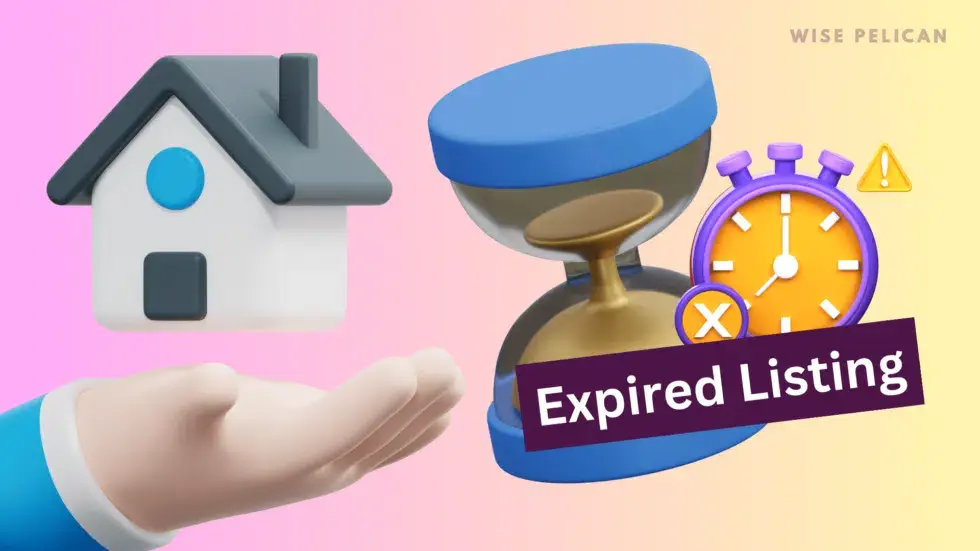
Expired Listing Letters
Mailing expired listing real estate letters to potential sellers using expired listing letters can be a highly effective way to connect with motivated sellers who may need more support with their previous listing experience. These homeowners have already expressed an interest in selling their property but have yet to succeed with their previous agent. Expired listing real estate letters to potential sellers
Let’s take a look at how to create and use these letters:
- Understanding Expired Listings:
- Motivated Sellers: Expired listings often indicate motivated sellers who may be eager to relist their property with a more effective real estate agent.
- Potential Challenges: Sellers of expired listings may have encountered challenges such as overpricing, inadequate marketing, or mismanagement of the listing process.
- Purpose of Expired Listing Letters:
- Renewing Interest: The main purpose of these letters is to bring back the seller’s interest in selling their property. Your goal is to become the solution to their previous listing problems.
- Customizing Your Letters:
- Personalization: Personalize your letters with the seller’s name and property address for a more personalized touch.
- Empathetic Tone: Start by acknowledging their experience and empathizing with their previous challenges. Let them know you understand their frustration and are committed to a better outcome.
- Showcasing Your Expertise:
- Highlight success: Share your track record of successfully selling properties in the area, mainly those previously listed but didn’t sell. Mention the number of days on the market, sale prices, and any unique strategies you used.
- Local Market Knowledge: Emphasize your in-depth knowledge of the local real estate market, including recent trends, neighborhood insights, and how these factors can impact their property’s sale.
- Pricing Strategies: Explain your pricing strategies and how you’ll ensure their property is competitively priced to attract buyers.
- Marketing Plan: Detail your comprehensive marketing plan, including both traditional and digital marketing strategies. Explain how you will maximize the property’s exposure to potential buyers.
- Professional Network: Highlight your extensive network of real estate professionals, from photographers to contractors, who can help prepare the property for sale.
- Legal Expertise: Mention your understanding of local real estate laws, contracts, and negotiations to ensure a smooth and legally sound transaction.
- Offering a Consultation:
- Call to Action: Encourage sellers to schedule a consultation with you. This allows you to assess their property, discuss their goals, and provide a personalized plan of action.
- Free and No Obligation: Emphasize that the consultation is free and carries no obligation. This can alleviate their concerns about committing to a new agent.
- Follow-Up Strategy:
- Persistent Follow-Up: Develop a follow-up strategy to keep in contact with expired listing homeowners. A steady follow-up through phone calls, emails, or additional letters can express your commitment and interest in helping them achieve their goals.
- Metrics and Results:
- Track Record: When sending these letters, consider including a section or an insert highlighting your recent successes, specifically with expired listings. Include data on how long it took to sell, sale prices achieved, and the initial listing price.
Targeting expired listings with customized letters is a proactive approach to winning over motivated sellers who may have had a frustrating experience with their previous listing.
By proving your expertise, local market knowledge, and commitment to a successful sale, you become the agent who can sell their property effectively and help them achieve their real estate goals.
Balancing Letters and Postcards
To effectively target home sellers, using a multi-faceted approach that balances both letters and postcards in your marketing strategy is crucial. This combination enhances the overall impact of your branding efforts while maintaining a sense of consistency.
Letters offer a personalized touch that can resonate with potential sellers on a deeper level. They provide an opportunity to generate a persuasive narrative, share success stories, and establish a genuine connection with homeowners.
On the other hand, real estate postcards are excellent for catching the attention of a wider audience.
They are concise and aesthetically pleasing, making them ideal for communicating important information quickly.
Postcards can feature ete-catching images of properties you’ve sold, showcase current listings, or highlight your unique selling points. Their visual appeal can leave a lasting impression on homeowners and ensure you are the one they think of first when they decide to sell their homes.
By using both letters and postcards, you create a comprehensive marketing strategy that uses the strengths of each medium.
Letters build trust and establish a personal connection, while postcards grab attention and reinforce your brand’s visibility.
This dual approach maximizes your chances of reaching potential sellers in different stages of the decision-making process and increases the likelihood of converting them into clients.
The Power of Persistence
Persistence is critical in real estate letters. Repeatedly mailing letters to potential home sellers can provide great results.
Initially, homeowners might find your outreach a bit annoying, but over time, your diligence demonstrates your commitment to their needs.
Building a Strong Real Estate Brand
Building a strong brand in the real estate industry is crucial for establishing credibility, trust, and recognition among potential clients.
Regularly mailing letters can be a highly effective strategy for brand building.
Let’s take a look at how this approach helps you create a strong real estate brand:
Consistent Brand Exposure:
- Repetition is Key: Consistency in mailing letters is essential because it reinforces your brand identity through repeated exposure. When potential clients regularly receive communications from you, they become more familiar with your name and company.
Postcards as Branding Tools:
- Visual Impact: Postcards are a visually appealing and concise medium for delivering your message. They offer a great canvas to showcase your brand’s visual elements, such as logos, colors, and imagery, essential for brand recognition.
- Memorable Format: Postcards are less likely to be discarded or overlooked than traditional enveloped letters. Their compact size and impressive design make them more memorable, increasing the chances of recipients remembering you when it comes to selling their homes.
Association with Real Estate Expertise:
- Content Matters: The content of your postcards should go beyond just promotion. It should provide valuable information on the real estate market, tips for homeowners, or updates on local market trends.
- Consistent Messaging: As recipients consistently receive postcards with insightful and helpful content, they associate your name and company with real estate expertise.
Creating Trust and Credibility:
- Reliable Presence: Consistency in mailing postcards demonstrates reliability. Potential clients see your commitment to staying in touch and assume you’ll be just as committed to handling their real estate needs.
- Positive Experiences: If your postcards always provide value and valuable insights, recipients will have positive experiences with your brand. This creates trust and credibility, which are vital in the real estate industry.
Reinforcement of Values and Culture:
- Message Alignment: Your postcards should align with your brand’s values and culture. Whether your brand is known for personalized service, innovation, or community involvement, ensure that your postcard content reflects these qualities.
- Consistent Tone: Maintain a consistent tone in your postcards that resonates with your brand. Whether it’s friendly and approachable or professional and authoritative, the tone should reflect your brand’s personality.

Wearing Down Resistance
“Wearing down resistance” is a concept often used in sales and marketing, and it holds particular relevance in the real estate industry. It refers to the persistent and patient approach that real estate professionals use to engage homeowners who may initially be hesitant to their services. Over time, this approach can gradually break down the barriers and convince homeowners of your dedication and seriousness.
Below is a more detailed explanation of how this strategy works:
- Initial Hesitation:
- Typical Scenario: Homeowners may initially hesitate to work with a real estate agent for various reasons. They might believe they can handle the sale independently, be wary of paying a commission, or have doubts about the value an agent can provide.
- The Relentless Approach:
- Persistent Outreach: Real estate professionals use a relentless approach by consistently reaching out to these homeowners. This can involve various methods such as phone calls, emails, direct mail, and in-person visits (where appropriate and welcomed).
- Engaging Content: The outreach is often accompanied by engaging and informative content. For example, agents may provide market updates, home-selling tips, or success stories to demonstrate their expertise and commitment.
- Personalization: Tailoring the communication to address each homeowner’s specific concerns and needs is essential. Personalization shows that the real estate professional is genuinely interested in helping them achieve their goals.
- Building Trust and Credibility:
- Demonstrating Dedication: Persistent outreach over time brings a sense of dedication and seriousness. Homeowners begin to realize that the agent is genuinely interested in assisting them, not just making a quick sale.
- Proving Expertise: Providing valuable information and insights during the outreach demonstrates expertise and industry knowledge.
- Addressing Concerns: As the relationship develops, the real estate agent actively listens to the homeowner’s objections and concerns. They work to address these issues through personalized solutions and explanations.
- Rebuttal with Evidence: Over time, the agent can present evidence of their success in selling similar properties or examples of how their services have maximized a seller’s profit. These real-life success stories can be persuasive.
- Staying Prevalent:
- Regular Contact: The relentless approach ensures that the agent remains familiar to the homeowner. Even if the homeowner is not ready to sell immediately, they are more likely to think of the agent when the time comes.
- Timing Matters: Real estate decisions often depend on timing, such as changes in the homeowner’s circumstances or shifts in the local market. By maintaining a presence, the agent increases the chances of being the go-to choice when the timing is right.
- Respectful and Ethical Approach:
- Respect Boundaries: It’s crucial for the real estate professional to respect the homeowner’s boundaries. If a homeowner explicitly states they are uninterested, the agent should refrain from overly aggressive tactics.
- Ethical Considerations: The agent’s approach should always align with ethical standards and industry regulations. It should never cross the line into harassment or pressure tactics.
“Wearing down resistance” in real estate involves a patient and persistent approach to gradually convince hesitant homeowners of your dedication and seriousness as a real estate professional.
Demonstrating expertise, addressing concerns, and providing value through consistent and personalized outreach can build trust and credibility over time, increasing the likelihood that homeowners will work with you when they sell their homes.
Over time, those who initially found you annoying may come to see you as a dedicated and passionate real estate agent who genuinely wants to help them sell their home.

Choosing Your Target Market When Mailing Real Estate Letters to Potential Sellers
Selecting the right target market is vital to a successful real estate marketing strategy, especially when mailing letters to home sellers.
Let’s look at some tips to help you make informed decisions when choosing your target market:
- Start in Your Backyard:
- Local Expertise: Beginning your marketing efforts in your local area offers several advantages. Your familiarity with the neighborhood allows you to position yourself as a local expert who understands the community’s unique features and can effectively market properties.
- Networking Opportunities: Local connections can lead to valuable referrals and networking opportunities. Neighbors and local businesses may recommend your services to friends and family in the area.
- Explore Absentee Owners:
- Untapped Market: Local agents often overlook absent homeowners who own property but don’t live in it. This oversight makes them an excellent target market because they may have yet to establish relationships with real estate professionals in the area.
- Potential Motivation: Absentee owners may have various reasons for wanting to sell, such as investment goals, property management challenges, or changes in personal circumstances. Identifying their specific motivations can help tailor your marketing approach.
- Wisepelican.com:
- Resource Hub: Wisepelican.com offers a wealth of resources for real estate professionals, including various real estate letters designed to secure listings. These resources can be invaluable, especially if you’re new to the industry or looking for fresh ideas.
- Templates and Customization: The website provides templates for different scenarios, from prospecting letters to follow-up messages. You can customize these templates to align with your brand, unique selling propositions, and the needs of your target market.
Additional Tips for Target Market Selection:
- Demographic Research:
- Conduct demographic research to identify target markets that align with your business goals. Consider factors such as income levels, age groups, family size, and lifestyle preferences when evaluating potential areas.
- Market Trends and Conditions:
- Stay updated on local market trends and conditions. This information can guide your target market selection. For example, if there’s a high demand for starter homes in your area, you might focus on first-time homebuyers.
- Competitor Analysis:
- Analyze your competitors’ target markets. Identifying gaps or underserved segments can help you find opportunities to stand out and capture a specific niche.
- Referral Networks:
- Leverage your existing network and referral sources to identify potential target markets. Personal referrals and recommendations can lead you to motivated sellers who fit your chosen demographic.
- Consistent Testing and Evaluation:
- Periodically review and adjust your target market strategy based on results. Conduct A/B testing of different market segments and messaging to determine which yields the best response and conversion rates.
Selecting the right target market when mailing letters to home sellers is invaluable in your real estate marketing efforts.
By beginning in your local area, exploring opportunities with absentee owners, and utilizing valuable resources like Wisepelican.com, you can identify and connect with potential sellers most likely to benefit from your services and expertise.
Reaching out to homeowners through letters remains a powerful strategy for agents focusing on growing their businesses. By using proof of production letters, targeting FSBOs and expired listings, and combining letters with postcards, you can easily create a successful marketing campaign that promotes your brand and highlights your dedication.
Explore Wise Pelican’s wide range of professional real estate letters designed to capture sellers’ attention.




